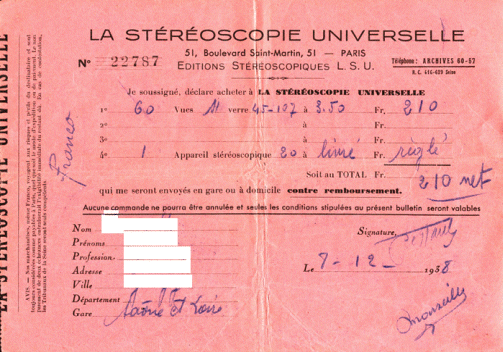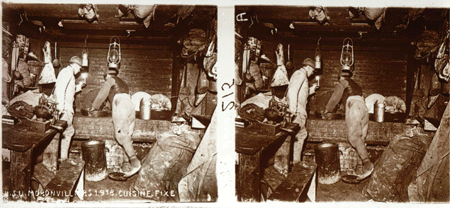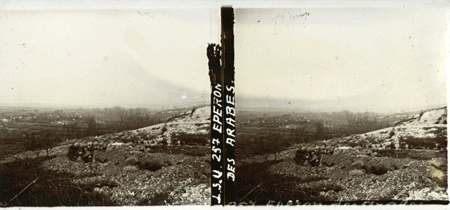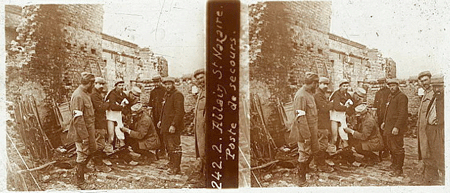 |
    |
        |

La Stéréoscopie Universelle (LSU)
Surprisingly for such a prolific producer of stereoviews in both small and medium formats, almost nothing is known about the company LSU. A 1938 bill provides the company address, 51 Boulevard Saint-Martin, Paris, in the center city. Tops of boxes commonly used for LSU slides bear the same name and address, but also the name "Rolland." The latter is also seen on boxes as "Les Éditions Rolland" without mention of LSU; these are probably later and retain the tourism-oriented topics but not the war. "Guilleminot" is usually associated with the type of glass plate, in this case plaques positives tons chauds (warm-toned positive plates). Another company, R. Guilleminot, Boespflug et Cie., 22 Rue de Chateaudun, Paris, produced stereographic plates, so the relationship with LSU/Rolland was probably not exclusive.
 |
 |
| LSU bill for a group of World War views sold to a French veteran in 1938. | Box top for LSU slides; box tops with this label were used for the set accompanied by the 1938 bill. |
Not all LSU views were marked as such, so association of specific views with this company relies upon analysis. Numerous glass views bear the initials "L.S.U." so their association is beyond question. The same images often bear added markings corresponding to the numbering scheme used by the Service des Ventes de l'Union Nationale des Combattants, so it is likely LSU operated that sellers' service for the U.N.C., a French veterans' organization similar to the American Legion. Groups of known LSU and SDV stereoviews almost always contain glass slides with distinctive text and numbers in the 8xxx-9xxx series. This association is not due to mixing of various brands of stereoviews. In otherwise homogeneous LSU groups, 8xxx-9xxx views are usually present. For example, the above bill is for 60 views, and that was the number of slides still packed with the bill in 2005. Of those 60 slides, five were from the 8xxx-9xxx series and did not have any LSU marking. That is nearly conclusive proof of the association of the 8xxx-9xxx series with LSU. That series of views includes many images used for paper stereoviews that lack any maker's name. The strength of the LSU association with 8xxx-9xxx views makes a strong connection between those glass views and the paper stereoviews.
LSU stereoviews can be dated approximately by the image number and style of the title bar. One hard data point is the founding of the U.N.C. shortly after the Armistice in November 1918. The date for establishing the SDV is not known, but the possession of an early version of its catalog by a US veteran suggests it was in 1919, before all American troops had left France and Germany. Therefore, any view bearing an SDV number is postwar.
Another excellent data point is a set of 209 medium-format LSU views packed in a marked wooden box from the collection of a famous French actor, Michel Simon, who died in 1975. He had one of the world’s largest collections of WWI glass slides. It is likely this was an intact set sold in 1918 during the war. None of the slides have SDV numbers and there are few that would have had to be censored at that date; the bodies and wrecked aircraft were German and no current troop dispositions were given away. Another intact set of known provenance is the one referred to above with 60 views and the bill of sale, purchased in 1938 by a WWI French veteran. It makes no mention of SDV, although several slides bear SDV numbers. The set includes a sub-group of 33 views marked “172:RI” showing the 172ème Regiment d’Infanterie during the war. Between them, these sets appear to bracket the SDV period. The medium-format set has many images to which SDV numbers were subsequently added. Both sets include the LSU views in the 8xxx and 9xxx series that were never included in the SDV List.
|
Title Bar Style and Numbers |
Typical Image |
|
|
1915. No title bar, title on image at bottom; number in clear space between images. Presumed earliest form, but this method of titling persisted until 1918. Seen with 3-digit image numbers. LSU stereoviews frequently have the numbers and some or all of the text reversed in relation to the image. The images on this site are shown in their correct orientation when that can be determined from the image itself. |
|
206—Massiges
1915. Poste d'écoute.
Massiges 1915. Listening post. |
 |
215—Moronvilliers
1918. Cuisine fixe.
Moronvilliers 1918. Permanent kitchen. |
|
| 1915. Partial title bar. Narrow strips would not contain all the printing. Occasionally the printing fit due to a neat writer or to title bars that were slightly wider. This was the predominant style for numbers up to 220 and a few later slides, including the 4xx Aviation series. Some views in this style were unnumbered. |  |
10—Bois de
Chevreux Après la bataille.
Bois de Chevreux After the battle. |
| 1915. Similar to the early type, but with both 3-digit and standard 4-digit numbers. |  |
2238—Mont-Tetu
Obus fusant.
Mont-Tetu Shell exploding. |
| 1915. A wider title bar that could accommodate the title soon became standard; 257 and higher numbers usually had wide title bars. Some early examples had sloppy, incomplete title bars. Some were also unnumbered. |  |
257—Éperon des
Arabes.
L'éperon des arabes, literally "the spur of the Arabs," was a piece of key terrain during combat in Artois in May 1915. |
| 1915. Title bar with transitional number of 3-digit series number, decimal point, and image number. |  |
242.3—Ablain St.
Nazarie Poste de secours.
Ablain St. Nazaire Aid station.
|
| 1915-16. Title bar written in black in clear center space as well as it bottom. The "L" of "L.S.U. is typically stylized—note how the bottom of the "L" becomes an underline for the other letters. Images using this form are usually dated 1915 or 1916. Standard 4-digit numbers. |  |
2147—Fort Tavannes 1916. |
|
1916-18. Slides with numbers higher than 2002 had title bars of higher quality. This is the most common type and has several variations. |
|
2002—Éparges
1916 Bombe Allemande.
Éparges 1916 German Bomb. |
|
Postwar (?). The 1938 set subgroup of 33 marked “172:RI” spanned numbers 1491-1660. The title bar contains neatly printed letters and lacks any “LSU” mark. No other examples of unit subgroups have been seen. Despite the low numbers, the title bar style suggests this series was produced after the SDV period, perhaps from stereographs taken by a private photographer in that unit. |
|
1507—Chemin des
Dames Au dessus de Soupir 172:RI.
Chemin des Dames Above Soupir 172 Inf Regt. |
Title bars of the LSU 8xxx-9xxx series have a distinctive appearance and cannot be mistaken for those of other manufacturers that used the same numbers. The style of printing is consistent. Varieties are few, and are likely to involve missing data. Paper stereoviews made from this series had the same titling style as other LSU paper views.
|
The center bar has a title and number that is well-printed and usually fits into the title bar area. |
|
8402—Organisation
des levres d'un entonnoir.
Organization of the sides of a crater. |
|
Title bars in the 8xxx series are often poor quality and difficult to read. |
|
8608 (?)—Entrée
de l'ouvrage des xxx
Entrance to the works of... Note the indistinct title and number. |
|
Title bars of 9xxx slides are usually regular and readable, even if occasionally dark. |
|
9016—Télégraphistes
américains pose des fils.
American signal unit stringing wires. |
|
Small format views often had part of the title information removed when they were converted from medium format. This appears to have been more common with 8xxx views than 9xxx, but there are examples in both series. |
|
8644—Entrée
du Fort de Souville.
Entrance to Fort Souville. Note much of "Souville: and "8644" have been cut off. |
| Paper stereoviews made from this series have the title and often the series name and sequence number printed directly on the image. A handful in the 9xxx series also bear the image number as shown here. |  |
9451—Arras—Hôtel
de ville
Arras—City Hall |
The total number of different LSU images is difficult to estimate. Many of their sales were of the same slides packaged in various ways, for instance the SDV series. The company also produced limited production series, including the 172ème Régiment d’Infanterie set described above and a medical set that may have included a few dozen stereoviews of wounds, all untitled. Other special series used views available elsewhere. There are probably more unique series to be discovered. The table below provides an estimate of LSU stereoviews, excluding the 870 SDV views, most of which, if not all, were produced by LSU.
| Type | Description (Click for Title List) | Number Seen | Estimated Number |
| Glass | Numbered <2000, excluding special series | 187 | 700 |
| Glass | 2xxx-3xxx series (2001-2299, a few in 23xx, 24xx, 26xx, and 27xx, 3001-3110) | 160 | 500 |
| Glass | 8xxx-9xxx series (8300-8999 plus 30 8000-8299, and 9000-9700) | 464 | 1400 |
| Glass | Special series: 172 RI (medical slides 1-36 lack titles ) | 43 | 150 |
| Subtotal, Different Images on Glass: | 849 | 2750 | |
| Paper | Paper stereoviews from the 8xxx-9xxx series | 182 | 300 |
| Total: |
1036 |
3050 | |
Copyright © 2007 Great War Photos. All rights reserved